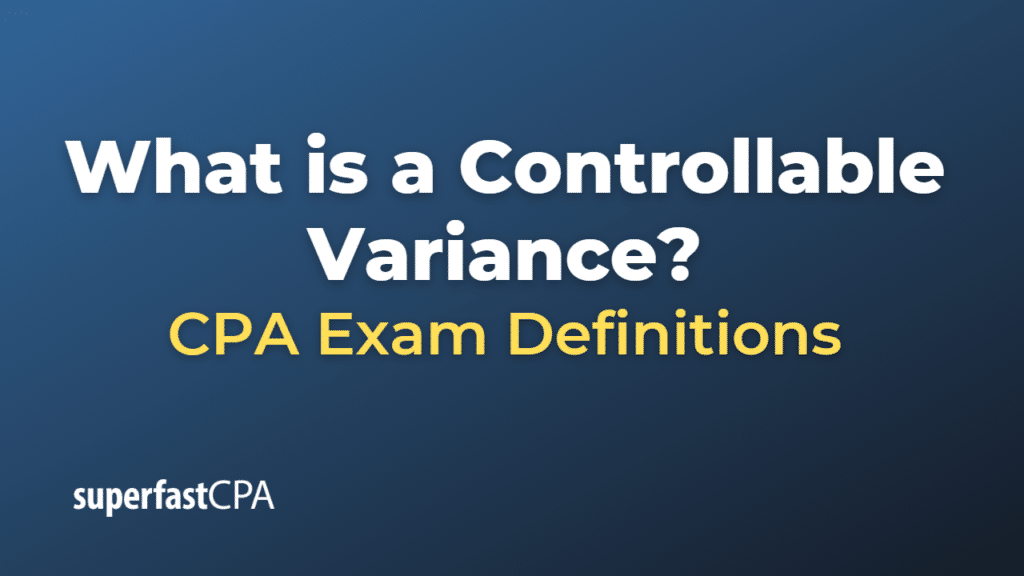Controllable Variance
A controllable variance is the difference between the actual cost incurred and the budgeted cost for a particular expense or revenue item that can be directly influenced, managed, or altered by the actions of managers or employees within an organization. Controllable variances arise when actual results differ from the budgeted or planned figures due to decisions, actions, or efficiency levels that are under the control of the management.
Controllable variances are often used in performance evaluation, cost management, and budgetary control. By analyzing controllable variances, management can identify areas where they have the ability to improve operations, control costs, or increase revenues. Positive controllable variances indicate that actual costs were lower than budgeted costs or actual revenues were higher than budgeted revenues, which is generally a favorable outcome. Negative controllable variances represent the opposite situation, where actual costs were higher than budgeted costs or actual revenues were lower than budgeted revenues, which is typically unfavorable.
Examples of controllable variances include:
- Direct labor variance: If the actual wages paid to employees involved in the production process are higher or lower than the budgeted amount due to overtime, productivity, or wage rate changes, this results in a controllable variance.
- Direct materials variance: The difference between the actual cost of raw materials used in production and the budgeted cost, which may arise from changes in material prices, efficient purchasing practices, or material usage.
- Marketing and advertising variance: If the actual marketing and advertising expenses are higher or lower than the budgeted amount due to changes in marketing strategies, selection of cost-effective channels, or negotiation of better advertising rates, this results in a controllable variance.
It’s important to note that some variances, such as those related to economic factors, market conditions, or external factors, are not considered controllable, as they cannot be directly influenced or changed by the actions of managers or employees within the organization. By focusing on controllable variances, management can identify opportunities for improvement and take appropriate actions to optimize costs and revenues.
Example of a Controllable Variance
Let’s consider a hypothetical example of a small bakery that creates a budget for its production costs, which include direct labor and direct materials. The bakery’s management team tracks actual costs and compares them to the budgeted costs to identify controllable variances.
- Direct labor budget: The bakery budgeted $10,000 for direct labor costs for a particular month, based on an estimated number of labor hours and an average wage rate.
- Direct labor actual cost: At the end of the month, the bakery finds that it spent $9,000 on direct labor costs.
- Direct labor variance: The actual direct labor cost is $1,000 lower than the budgeted cost, resulting in a positive controllable variance of $1,000. This favorable variance could be due to higher employee productivity, fewer labor hours used, or lower wage rates than initially budgeted.
- Direct materials budget: The bakery budgeted $8,000 for direct materials costs for the same month, based on estimated quantities of ingredients and their average prices.
- Direct materials actual cost: At the end of the month, the bakery finds that it spent $9,500 on direct materials costs.
- Direct materials variance: The actual direct materials cost is $1,500 higher than the budgeted cost, resulting in a negative controllable variance of $1,500. This unfavorable variance could be due to higher ingredient prices, inefficiencies in material usage, or higher-than-anticipated quantities of ingredients used in production.
By analyzing the controllable variances, the bakery’s management team can identify areas where they have the ability to improve operations, control costs, or increase revenues. In this example, the favorable direct labor variance suggests that the bakery’s labor costs were well managed. However, the unfavorable direct materials variance indicates that there might be room for improvement in the bakery’s purchasing practices, material usage efficiency, or inventory management.
The management team can use this information to take appropriate actions, such as negotiating better deals with suppliers, implementing more efficient production processes, or revising their budgetary assumptions to better align with actual costs and revenues.












